Boo!
I love teaching guided reading at Halloween time—especially to emergent readers! I’d like to share some of my teaching points and materials with you.
Most kindergartners and 1st graders like to be a little bit scared, but, even more than that, they love to scare adults! This is why they are eager to learn to read and write boo, and much of my teaching this time of the year centers around the word.
Boo!
Of course the focus of your guided reading lesson should be whatever book you have chosen, and we’ll get to that, but I’m going to start this post by talking about word work.
Phonics
By the time Halloween rolls around, I have already taught the sight words to and too, so I start phonics instruction there. I have the kids use magnetic letters and whiteboards to change the initial consonant in too to make boo. Creating moo and zoo adds more to the fun. (You can imagine what a bunch of 6-year-olds do with the words moo and boo once they learn them!)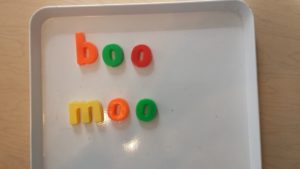
I also use this opportunity for a little phonemic awareness, removing the initial consonant to leave just the phoneme oo (the long sound of oo, as in boo). Kids love learning that creepy ghost sound, and it beneficial to give them practice with adding, deleting, and changing initial sounds.
Next I show my emergent readers how to add consonants to the ends of words. Take boo and ask the children what consonant they would add to make boot or boom. Or write moo and ask how they could turn it into moon. Repeat with too>tool, zoo>zoom.
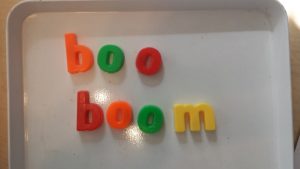
If the students are ready for blends and consonant digraphs, we even change the initial b in boo to br to make broom or change boo to shoo. It’s instructive for the kids to discover that they can replace single consonants with consonant combinations, and change back from two- to one-letter beginnings. You can see that many kinds of word changes are possible.
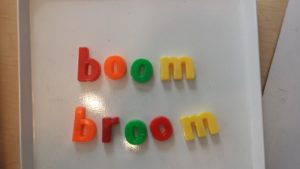
At this time, my students are also already familiar with the sight word look, so I explain (if I haven’t already) that oo can make two sounds–as in look and boo. I either have the children complete his worksheet on their own, or dictate words to them to write in the correct columns. You can download this free resource, which also includes flashcards of oo words.
Concepts of Print
The word boo provides a great opportunity for teaching the exclamation mark and reading with expression. Boo! But beware! Once children learn the function of this punctuation mark you are going to find lots of them in their writing!!!!!!!!!! (See what I mean?)
I love Halloween !!!!!!!!!!!
I also make sure my students don’t think that the exclamation mark is part of the word Boo!
Sometimes I have students who confuse lowercase b with other letters, especially d. These downloadable free pages give practice with reading and writing b:
Grammar
Children have fun sorting fall and Halloween words according to their parts of speech: nouns, verbs, and adjectives. I believe that kids generally enjoy learning holiday and season words because that helps them learn more about the world around them. I created this parts of speech resource based on that theory:
Writing
What are children focused on during the weeks leading up to Halloween? I would say that they are primarily thinking about their Halloween costumes. It used to be that kids created their own costumes, with a little help from their parents.
(I know I’m aging myself now. One of my most memorable costumes was when I was the rear end of a horse, with my friend Mimi being the front end. I know what you’re thinking–that I was the horse’s you-know-what! And you’re right!)
But now, even though costumes are often purchased ready-made, youngsters still enjoy thinking about what they are going to be on Halloween. I use this to my advantage, and have my students read and write about what their costumes are going to be. (See below: On Halloween.) Here is a simple sample (downloadable and free) of my longer paragraph-writing resource on this topic. 
Simple sample
Longer Lesson Plan
Leveled Books
Of course the most important part about guided reading is the books. I’ve written a few books about Halloween: two published traditionally, two available on Teachers Pay Teachers, and several more in the process of being published. In other words, more to come!
Boo! (Educators Publishing Service/School Specialty Intervention)
I’m very pleased with this book (Level B/2), and the kids love reading it–although it’s not technically a Halloween story.
In the story, a little girl hides around her home, scaring her mom and dad. (I got the idea for this book because my stepson used to hide and scare me all the time!) The word Boo is repeated several times in the text and provides a great opportunity for introducing reading with expression. Readers must also self-monitor with sight words and one-to-one matching of voice to print.
Halloween (Educators Publishing Service/School Specialty Intervention)
As you can see, the most wonderful part about this leveled reader (Level C/4) is the unusual illustrations done by the talented artist Tatjana Mai-Wyss. She also illustrated Boo! Thanks, Tatjana! (I encourage you to visit her website, tatjanamaiwyss.com.
Back to Halloween. The text is sight word based, but the readers also learn the sound oo, which they love to read with creepy expression! Along with oo, the sight word too also appears over and over in the book. Three punctuation marks are part of the book as well: the period, exclamation mark, and question mark, so that’s another reason this book is good for teaching expression. The book ends with word boo.
I See a Ghost (Teachers Pay Teachers)
This emergent reader text (Level B/2) is good for students who know a few sight words but are working on one-to-one matching and beginning to use phonetic cues. The main sentence pattern is “I see a…” but there are several changes in the syntax, so readers have to attend to the print. The picture support is strong. The last word in the text is Boo, in a speech bubble.
(An aside: My view is that exposing emergent readers to patterned text for too long is dangerous, because they can come to believe that reading consists of looking at pictures and memorizing the sentence pattern.)
On Halloween (Teachers Pay Teachers)
The sentence pattern in this book (Level C/3) is longer and more varied than in I See a Ghost. At times the sentence starts, “On Halloween I am going to be a…” and at other times it starts, “I am going to be a …on Halloween.” Thus, the kids have to self-monitor, and can’t just parrot the sentence pattern.
The word boo does not appear in this text, but at the end, a monster says, “Aaaa!” This offers a way to learn short-a. The book also provides a wonderful opportunity for follow-up writing, since it’s about what different children are going to be on Halloween.
The bundled versions of the I See a Ghost and On Halloween
The bundles of these books are wonderful for guided reading teachers, because the kits contain everything they need to teach the guided reading lesson, including doing word work and conducting an assessment.
- 16-page storybooks in full color and black & white
- sight word flash cards
- pocket chart sentence strips
- tabletop sentence strips
- running record form with book text
- writing activities
What’s Next?
I can’t wait to write more Halloween books! It’s fun to write books that will help kids learn to read better, and have fun at the same time!
You can check out more Halloween activities at my store, Many Roads to Reading! I promise I won’t scare you!
Boo!
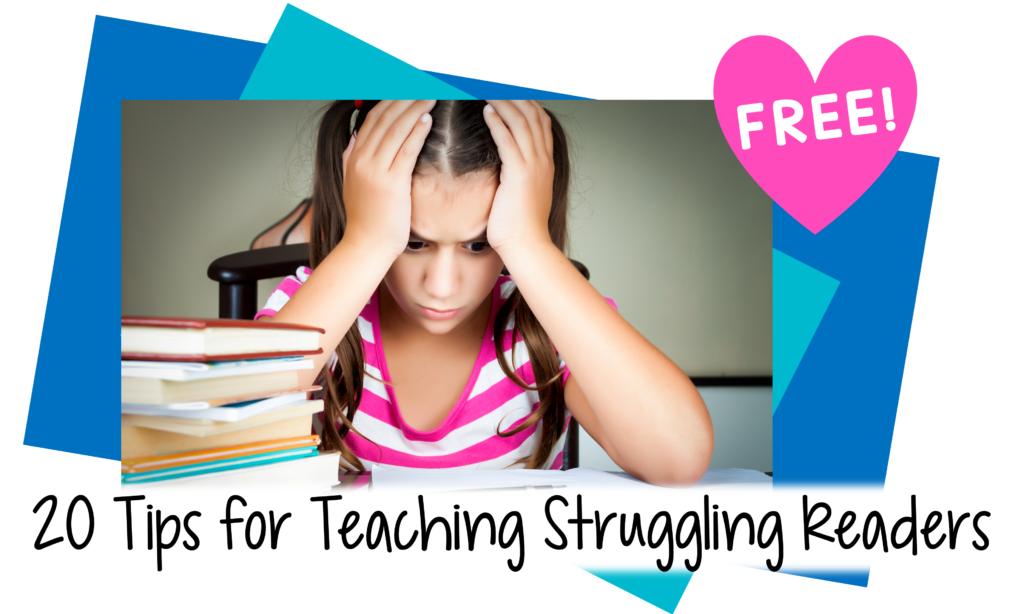
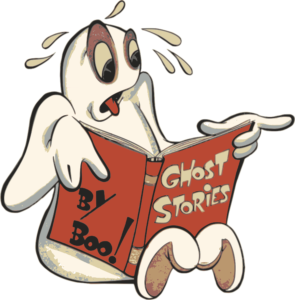


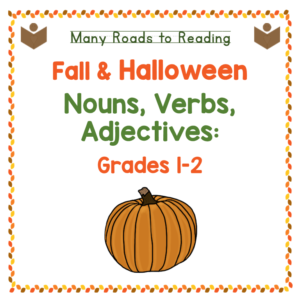
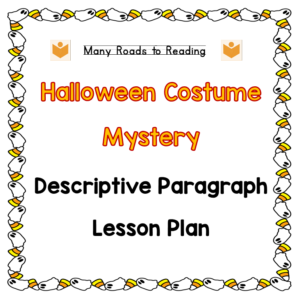
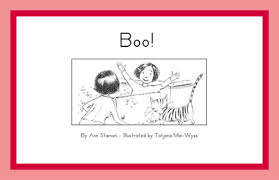

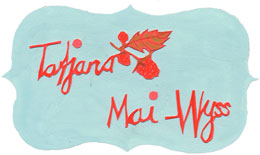

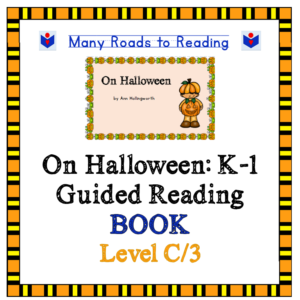
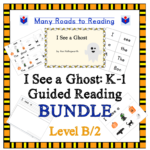
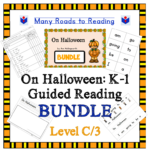

2 Comments
Leave your reply.